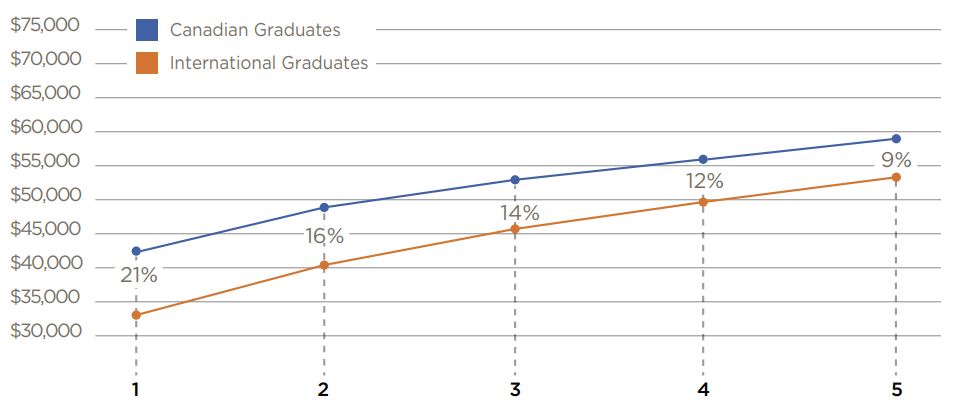Table of Contents
Key Findings
- Overall, international students who graduate from Canadian post-secondary education institutions and remain in Canada to work afterward earn less than Canadian graduates, but the difference narrows over time:
- In the first year, international student graduates earn $33,900, about $8,900 (or 21%) less than Canadian graduates. This overall difference narrows in each subsequent year, reaching $5,300 (or 9%) five years after graduation.
- The difference is largest among master’s degree holders in education, at $32,400 (40%).
- In most cases, the earnings differences between international and Canadian students in STEM fields (science, technology, engineering and math) is less than in BHASE fields (business, health, humanities, arts, social science and education).
- In these broad STEM and BHASE fields, international students earn less than Canadians with regards to every credential except one: international STEM graduates with college-level certificates earn 7% more.
Introduction
How Much Do They Make? is a report jointly published by the Labour Market Information Council (LMIC) and the Education Policy Research Initiative (EPRI). The report focuses on the earnings outcomes of all students who graduated from publicly funded Canadian post-secondary education (PSE) institutions in 2010. Using the newly available Education and Labour Market Longitudinal Platform (ELMLP), we were able to follow graduates’ earnings from 2011 to 2015 (Box 1). The LMICEPRI report focuses on 11 primary fields of study across six credentials (five of which are available for international student graduates). The data can be further explored and downloaded on our interactive dashboard.
This LMI Insight Report compares the earnings of Canadian and international student graduates1 from two broad fields of study across five credentials.2 The first field includes science, technology, engineering and mathematics - a group commonly known as STEM. Non-STEM fields of study include business, humanities, health, arts, social science and education (or BHASE). We construct these two broad fields of study based on Statistics Canada’s definitions, which means aggregating up from the most detailed program of study codes available (six digit Classification of Instructional Programs [CIP] codes).3 For each of these broad fields of study, we focus on the earnings of graduates across five credentials for which the data are available: college-level certificates, college-level diplomas, bachelor’s degrees, master’s degrees and doctoral degrees. There are a number of important caveats and limitations associated with the platform that should be kept in mind when interpreting the reported results (Box 2).
Box 1. What is the Education and Labour Market Longitudinal Platform?
Developed by Statistics Canada and Employment and Social Development Canada, the newly released Education and Labour Market Longitudinal Platform (ELMLP) is a data environment that allows us to identify all college and university graduates from publicly funded Canadian PSE institutions starting in 2010 and follow their annual employment earnings through their tax records from the first year after graduation through 2015. The 2010 cohort of graduates currently has the longest period of available tax records (five years), so it is the focus of the LMIC-EPRI joint report, How Much Do They Make?. The associated data are available on our interactive dashboard. For additional information, please visit our ELMLP project page.
Earnings Differences Between Canadian and International Graduates
Overall, international students who graduated in 2010 earn less than their Canadian counterparts, but this difference narrows over time (Figure 1). Note that there are far more Canadian than international student graduates in the labour market. For the 2010 cohort of graduates across all credentials, there are 189,560 Canadians versus 9,360 international students (i.e. international graduates comprise less than 5% of the total).4 In the first year after graduation, international student graduates earn $33,900, about $8,900 (or 21%) less than Canadian graduates. This overall difference narrows in each subsequent year, reaching $5,300 (or 9%) five years after graduation.
Box 2. Limitations of the Education and Labour Market Longitudinal Platform
Although the administrative datasets available in the platform offer expansive coverage of students and apprentices, there are several limitations and corresponding caveats associated with using the ELMLP to measure earnings differentials. These include the lack of information available about hours and weeks worked, and about schooling and occupational choices (see LMI Insight Report no. 4).
The platform does not yet include information about key labour market factors, such as occupation, hours worked per week, and full- or part-time job status. As a result, we are unable to analyze labour supply decisions and constraints that affect the labour market outcomes of PSE graduates, including their earnings differentials. There are plans to link data sets such as the 2016 Census and 2018 National Graduate Survey to the existing ELMLP data in 2020. This will enable researchers to analyze detailed occupation and demographic information for certain years.
Figure 1. Average earnings differences between Canadian and international graduates (2016 constant $)

Years since graduation
Largest Earnings Differentials by Detailed Fields of Study
Across the 11 fields of study explored in the full report, there are only two groups of international students who earn more than Canadians five years after graduating: those who hold master’s degrees in mathematics, computer science and information sciences (8% more) or in health and related fields (6% more). Across the four credentials observed at this detailed field of study level,5 international student graduates earn less in every field. Table 1 summarizes the largest differences in both percentage and dollar terms.
The detailed fields of study with the largest earnings gaps are different within each credential, underscoring the fact that differences at the credential level are driven by gaps within fields of study. Notably, the largest absolute ($) and relative (%) differences, respectively, are found among master’s graduates in business, management and public administration and in education. International master’s graduates in business, management and public administration earn $37,800 (or 35%) less than Canadians, while those in education earn 40% (or $32,400) less five years after graduation.
Table 1. Fields of study with the greatest differentials in each PSE credential five years after graduation
| PSE crendential | Field of Study | Canadian ($) | International ($) |
|
|||||
|---|---|---|---|---|---|---|---|---|---|
| College-level diploma | Architecture, engineering and related technologies (international student share: 6%) | 65,100 | 53,700 | -11,400 | -18% | ||||
| Bachelor’s degree | Agriculture, natural resources and conservation (international student share: 5%) | 58,100 | 35,300 | -22,800 | -39% | ||||
| Master’s degree | Business, management and public administration (international student share: 8%) | 106,600 | 68,800 | -37,800 | -35% | ||||
| Education (international student share: 2%) | 80,900 | 48,500 | -32,400 | -40% | |||||
| Doctoral degree | Physical and life sciences and technologies (international student share: 8%) | 69,200 | 55,600 | -13,600 | -20% | ||||
*The difference is calculated as International graduates’ earnings minus Canadian graduates’ earnings divided by Canadian graduates’ earnings.
Earnings Differences Between International and Canadian Graduates in STEM Versus Non-STEM Fields of Study
Interesting patterns emerge when exploring the earnings differences by broad fields of study across five credentials observed at this level. There are substantial earnings differences between international and Canadian student graduates within four of the five credentials, but these differences narrow over time. The exception is international college-level certificate STEM graduates, who earn more compared with their Canadian counterparts in each year. As shown in Table 2, international students with college-level certificates in STEM fields earn more in their first year after graduation ($8,600 or 18%) as well as five years out ($4,100 or 7%).
Focusing on bachelor’s degree holders - who represent the largest share of graduates - international students in STEM fields earn $6,300 (13%) less than Canadian graduates in the first year after graduation. By year five, international graduates earn $7,700 (11%) less than Canadians. Among BHASE graduates, the differences are much larger: international students earn $11,700 (29%) less in year one and $10,700 (19%) less in year five.
The largest earnings difference between Canadian and international student graduates is among graduates with master’s degrees in BHASE. In the first year after graduation, international students in these fields earn $31,300 less than Canadian master’s holders - a difference of 45%. While the difference reduces substantially over time, by the fifth year following graduation, international students still earn $23,300 (27%) less than Canadian students.
It is commonly observed that across bachelor’s, master’s and doctoral degree holders, the gap between Canadian and international students is substantially larger among those in BHASE fields of study than among those in STEM fields. Among master’s graduates, the earnings difference is two times larger one year after graduation (22% difference for STEM graduates versus 45% for BHASE student), and nearly four times larger five years out (7% in STEM and 27% in BHASE). Similarly, international students with doctoral degrees in STEM fields earn virtually the same as their Canadian counterparts (only $1,200 or 1% less), whereas international graduates in BHASE fields earn $14,100 (14%) less.
Table 2. Earnings levels and differences for Canadian and international graduates (2016 constant $)
| PSE crendential | Broad Field of Study | Year since graduation | Canadian ($) | International ($) |
|
|||||
|---|---|---|---|---|---|---|---|---|---|---|
| College-level certificate | STEM | Year 1 | 47,800 | 56,400 | 8,600 | 18% | ||||
| Year 5 | 61,900 | 66,000 | 4,100 | 7% | ||||||
| BHASE | Year 1 | 35,100 | 29,900 | -5,200 | -15% | |||||
| Year 5 | 46,000 | 41,800 | -4,200 | -9% | ||||||
| College-level diploma | STEM | Year 1 | 43,100 | 33,300 | -9,800 | -23% | ||||
| Year 5 | 62,200 | 51,200 | -11,000 | -18% | ||||||
| BHASE | Year 1 | 33,400 | 26,500 | -6,900 | -21% | |||||
| Year 5 | 44,100 | 37,100 | -7,000 | -16% | ||||||
| Bachelor’s degree | STEM | Year 1 | 47,000 | 40,700 | -6,300 | -13% | ||||
| Year 5 | 72,400 | 64,700 | -7,700 | -11% | ||||||
| BHASE | Year 1 | 40,200 | 28,500 | -11,700 | -29% | |||||
| Year 5 | 55,900 | 45,200 | -10,700 | -19% | ||||||
| Master’s degree | STEM | Year 1 | 58,700 | 45,700 | -13,000 | -22% | ||||
| Year 5 | 78,700 | 73,300 | -5,400 | -7% | ||||||
| BHASE | Year 1 | 69,100 | 37,800 | -31,300 | -45% | |||||
| Year 5 | 85,400 | 62,100 | -23,300 | -27% | ||||||
| Doctoral degree | STEM | Year 1 | 56,400 | 51,700 | -4,700 | -8% | ||||
| Year 5 | 81,600 | 80,400 | -1,200 | -1% | ||||||
| BHASE | Year 1 | 66,000 | 46,600 | -19,400 | -29% | |||||
| Year 5 | 84,900 | 72,800 | -12,100 | -14% | ||||||
*The difference is calculated as International graduates’ earnings minus Canadian graduates’ earnings divided by Canadian graduates’ earnings.
The Way Forward
The ELMLP data indicate that international students who stay and work in Canada following graduation earn, on average, significantly less than their Canadian counterparts upon entering the labour market. However, the earnings gaps narrow over time, both overall and within the two broad fields of study (STEM and BHASE). This narrowing tendency is unlike the differentials observed between female and male graduates, where the gaps widen within each credential in the years following graduation.
It is important to bear in mind that while the ELMLP provides near-complete coverage of earnings for graduates from Canadian PSE institutions, it currently offers very limited details about the type of work graduates are doing (e.g., full- or part-time, occupation, detailed industry). These details may underpin some of the differences in earnings.
The earnings information reported here and in our interactive dashboard represent only one piece of information that people should consult when considering whether and how to further their education and training. For a decision of such magnitude, students should consider earnings in combination with other labour market information as well as personal interests and abilities, and guidance from family and others.
Acknowledgments
This LMI Insight Report was prepared by Young Jung and draws heavily on the joint LMIC-EPRI report on earnings of post-secondary graduates by credential and field of study. We would like to thank Ross Finnie, Michael Dubois and Masashi Miyairi from EPRI for their feedback on this LMI Insight Report.
End Notes
- International students represent non-permanent residents of Canada and are compared with Canadian students, representing persons who are born Canadian, are naturalized Canadian citizens or are resident non-citizens enrolled as Canadian students. International student status is captured at graduation in the Postsecondary Student Information System (PSIS), not in the tax data. Immigration status may change after graduation, but this information is not currently available on the ELMLP.
- The sixth credential — professional degrees —primarily encompasses specialized medical programs (e.g., for doctors, pharmacists, optometrists, etc.) and legal professions (i.e. qualification for lawyers). Because there are few international students in these programs, the sample sizes are too small to extract from the raw data in the ELMLP.
- Note that the joint LMIC-EPRI report focuses on 11 primary fields of study. While some of these 11 fields are more closely associated with the broader STEM group (e.g., mathematics, computer and information sciences) and others the BHASE group (e.g. humanities), these more detailed 11 fields of study cannot be directly aggregated into the STEM/non-STEM categorizations.
- See the report for more information on the sample selection criteria.
- At the credential level and when looking at the broad STEM and BHASE fields of study, we observe five fields of study. At the detailed field of study level, there is not a sufficient number of international students with college level certificates to pass Statistics Canada’s privacy-protecting suppression rules.


